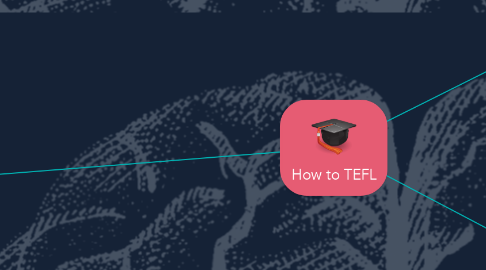
1. Approaches & Methods
2. Approaches
2.1. Grammar translation
2.1.1. The grammar translation method: This method of teaching English is heavy on grammar and depends on translation. It is the classic way to learn a language and is still used today. There are countries that still use this method of teaching and the main idea is that the students learn all the grammar rules, so that they can translate the sentences. This is common for those students who will study literature at a deeper level.
2.2. Audio-lingual
2.2.1. The Audio Lingual method: is based on the behavioral theory that things are learned through constant exercise. However, as in the military, when someone misbehaves, in this case the misuse of English, the student receives negative feedback, whereas when a student demonstrates good performance, he or she receives good criticism. This is related to the Direct Method, since only the target language is used. The only difference between the direct method and the audio linguistic method is the teaching approach. The direct method focuses on teaching vocabulary while the audio linguistic method focuses on specific grammar.
2.3. Communicative approach
2.3.1. This approach is based on the idea that learning language comes through real meaning communication. Classroom activities guided by this approach are characterised because their purpose is trying to produce meaningful and real communication.
2.4. The silent way
2.4.1. The silent way emphasizes the autonomy of the student. The teacher acts simply as a facilitator trying to encourage students to be more active in their learning. The main point of this type of teaching is that the teacher is not so active so that the students are able to take control of their own learning. There is a great emphasis on pronunciation and a large part of the lesson is focused on it. This method follows a structural program and the grammar, vocabulary, and pronunciation are constant to recycle reinforcement. The teacher evaluates their students through careful observation, and it's even possible that they may never set a formal test as learners are encouraged to correct their own language error.
2.5. Task-based learning
2.5.1. Use of authentic language and meaningful tasks using L2.
2.6. Whole language approach
2.6.1. It is a method were children are taught how to read by making them understand how words are put together and used to create meaningful sentences in a language.
2.7. Lexical approach
2.7.1. The idea is that grammar comes only second to Lexis, or words. But by “words,” it's not about vocabulary or individual words here. It is more related to “chunks,” or phrases. Words that usually go together and are commonly found next to each other in the language.
2.8. Competency based instruction
2.8.1. It is a system of instruction, assessment, grading, and academic reporting. It's based on students demonstrating their knowledge and skills. They are expected to learn as they progress through their education
2.9. Situational language teaching
2.9.1. The main objective of Situational Language Teaching involve accurate use of vocabulary items and grammar rules to achieve a practical mastery of the four basic skills. Pupils must be able to produce accurate pronunciation and use of grammar. The last purpose is to be able to respond quickly and accurately in speech situations with a basic control of structure and sentence patterns.
3. Methods
3.1. Direct method
3.1.1. It is used to teach different languages, not only English, and the main objective of this method is that students only use the target language to learn It focuses primarily on oral skills and is taught through repetitive language exercises. Grammar is inductive and students have to guess the rules through the teacher's oral presentation.
3.2. TPR
3.2.1. It is an approach that has "learning by doing" as its main idea. Students will learn English through a series of repetitive actions. With TPR, the most important skill is listening comprehension and everything else will follow naturally later.
3.3. The natural approach
3.3.1. The natural approach lessons are focused on understanding messages in the foreign language and place little to no importance on error correction, drilling, or on conscious learning of grammar structures.
3.4. Suggestopedia
3.4.1. This method is a behavioral theory and is directly related to pseudoscience. It is based on a measure of the students' belief in the effectiveness of the method. This theory offers students several options, which helps them to be more responsible in their learning, based on the physical environment of the class. It is essential that all students feel comfortable and confident when learning. When teachers are training to use this method, there is a lot of art and music involved. It is divided into three different phases. 1. deciphering, 2. concert session 3. elaboration.
3.5. Content based instructions
3.5.1. It focuses not on the language only but rather on what is being taught through the language; in other words, the language becomes the medium through which something new is learned.
3.6. CLIL
3.6.1. The idea is to help students communicate more effectively and correctly in real life situations. This type of teaching involves focusing on important functions such as suggesting, thanking, inviting, and complaining, among others.
3.7. Project based learning
3.7.1. It's an instructional approach designed in order to give students the opportunity to develop knowledge and skills. This is done through engaging projects set around challenges and problems they may face in the real life situations.
3.8. Eclecticism
3.8.1. It refers to a teaching approach that is not based on a single method (For instance, CLIL, TPR, Direct method, etc.) but that draws on several different method principles that are made use of in practice.
3.9. ARC/ OHE III/ ESA
3.9.1. It stands for Authentic (activities are those in which the language is not restricted.) , Restricted (activities are those which restrict the students to using specific linguistic items.), and Clarification (refers to any activity in which the language is explained to the students.) It has a close relation with PPP ( Presentation, Practice, Production)
